[FR] Silex, Flint et Lapis Pyromachus
Le nom de silex remonte au fait préhistorique que les silex peuvent en fait déclencher un incendie ; c'est-à-dire que lorsque les silex et le métal sont frappés les uns contre les autres à angle droit, des étincelles formant un feu sont créées qui, en combinaison avec de l'amadou (un champignon) et de la paille / du foin sec, peuvent allumer un incendie.
Pour cette raison, le chimiste allemand Martin Heinrich Klaproth (1743 à 1817) a également appelé le silex "Lapis Pyromachus" - la pierre à feu.
Le silex est souvent assimilé au terme silex. En fait, en géologie, le terme silex est utilisé pour décrire le silex qui a été créé dans la période comprise entre le Crétacé et le Tertiaire inférieur (environ 145 à 61,6 millions d'années).
En Europe, on trouve de grandes quantités de silex altérés des falaises de craie du Crétacé de la mer Baltique et de la Manche
Propriétés du silex
Définition du silex : Le silex, également appelé flint, est une roche sédimentaire qui a été créée dans des conditions marines (= dans la mer).
Le silex frais est généralement de couleur noire à grise. En raison des intempéries, il devient de plus en plus laiteux. La couleur du silex peut être grise, brune, noire, verdâtre ou rouge ; Des mélanges de matières organiques ou de composants minéraux, surtout l'hématite, qui donne aux silex une couleur rougeâtre, sont responsables de la couleur. Mais les gaz ou l'eau contenus dans la roche peuvent aussi avoir une influence sur la couleur des silex, qui s'exprime par des couleurs plus claires.
D'un point de vue chimique, le silex est constitué de dioxyde de silicium sous la forme de la variété de quartz microcristallin calcédoine ou moganite, parfois aussi d'opale, comme composant principal avec une teneur en eau indéfinissable (SiO2*nH2) - c'est pourquoi la roche est attribuée aux cailloux. Un terme aujourd'hui obsolète et qui résume en réalité les pierres constituées de silice.
La roche à grain fin est amorphe (les cristaux ne se forment pas), forme des agrégats nodulaires ou plats. Une croûte ou patine blanche se forme souvent à la surface des nodules de silex suite à la perte d'eau cristalline.
Le silex se caractérise par sa structure amorphe, isotrope (absence d'orientation préférée). Si une pression importante s'exerce brusquement ou de plus en plus sur un point du silex, l'énergie cinétique est absorbée par la roche et se propage concentriquement dans la roche, à partir du point d'impact. Si l'énergie d'impact est suffisamment élevée, la roche est fendue par la propagation des ondes d'impact. Le front de fracture qui en résulte a généralement une forme conchoïdale, comme on peut également l'observer sur du verre brisé. Dans la zone d'un point de fracture, le silex a par ex. Ondes de choc, les lignes de Wallner. Ils surviennent surtout avec des parties intentionnellement clivées de la pierre, appelées éclats.
Le silex est une roche dure avec une dureté Mohs de 6,5 à 7 sur l'échelle à 10 degrés de dureté des minéraux et des roches selon le minéralogiste Friedrich Mohs (1773 à 1839), la densité est de 2,5 à 2,6 g/cm3.
Origine et distribution des silex
La formation de nodules de silex se produit en plusieurs étapes et n'est pas entièrement comprise.
Les silex d'aujourd'hui ont commencé à se former dès le passage du Jurassique au Crétacé il y a environ 145 millions d'années. Les substances inorganiques - par exemple la roche silicatée altérée - et les substances organiques telles que les coquilles et les squelettes d'éponges siliceuses, de diatomées (algues de silice) et de bryozoaires (animaux de mousse) dans l'eau de mer ont fourni la matière première pour les silex.
Pendant des millions d'années, les solutions siliceuses ont déplacé les carbonates des squelettes des fournisseurs d'acide silicique ; L'acide silicique est la pierre angulaire des silex. Dans la première étape, l'acide silicique se solidifie en un gel en libérant l'eau qu'il contient - une opale amorphe se forme.
Les phénomènes de dissolution et de recristallisation caractérisent la deuxième étape - la formation de porcellanite, c'est-à-dire d'opale cristalline irrégulière se développe.
Lorsque le durcissement diagénétique est terminé, tous les composants carbonatés de la roche sont remplacés par du dioxyde de silicium. Les squelettes ou les coquilles peuvent souvent être considérés comme des preuves de l'implication organique dans la formation de la roche de silex.
De fines bandes dans le silex, résultant de différents niveaux d'acide silicique et de solidification, dits silex rubanés, prouvent que la silicification procède de l'intérieur vers l'extérieur.
Les dieux poulets sont aussi des silex dans lesquels la chaux non silicifiée a été emportée par l'eau de mer, laissant un trou dans la roche.
Trouvez des exemples :
On voit ici des inclusions à la fois irrégulières et nodulaires de silex noir dans une roche plus claire, qui est en fait un calcaire fortement silicifié déjà transformé en silex - ou pour le dire autrement : un silex pas encore complètement décalcifié. L'élimination de l'eau cristalline du silex noir lors de la diagenèse crée une frange d'opale blanche - particulièrement belle dans cette pierre.
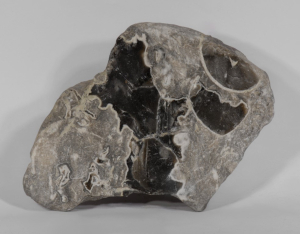
En raison de la situation initiale variable de type gel aqueux ou après l'altération des dépôts de craie ou même d'une tige de nénuphar fossile, des trous ronds peuvent apparaître dans le silex. Ces pierres perforées étaient considérées comme une amulette dans les temps anciens.
Issus de l'ancienne tradition slave, ils sont appelés "HAGSTONES (en anglais)" dans la région de la mer Baltique et sont collectés par les touristes comme porte-bonheur.
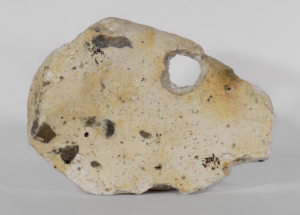
Les fusils de chasse ont très souvent un motif rayé. Ces bandes peuvent être attribuées à la précipitation rythmique de minéraux sombres (poussières fines) pendant la diagenèse. Les silex rubanés peuvent être très attractifs graphiquement.
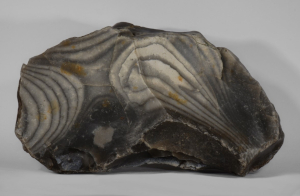 |
 |
| |
concrétions irrégulières |
| |
|
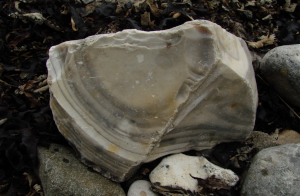 |
 |
| anneaux de croissance rythmiques |
précipités rythmiques |
Bien que le silex apparaisse amorphe à l'œil (= informe, c'est-à-dire sans formes cristallines reconnaissables), des cristaux de roche peuvent se former dans la substance d'acide silicique dans les fissures et les cavités.
Les très petits cristaux recouvrent souvent des cavités existantes en forme de "pelouse".


Rarement, on peut voir de la calcédoine bleue développée, elle apparaît également sur les surfaces des fissures et se présente sous la forme d'une pelouse de minuscules formations nuageuses sphériques. Parfois, les fusils de chasse lisses ont partiellement une surface légèrement bleutée. Cela peut être causé par les résidus d'un revêtement de calcédoine.
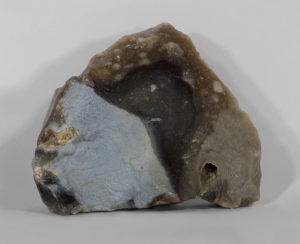
Sur une plage exposée au martèlement des vagues, même le fusil de chasse dur et tranchant s'arrondit avec le temps.
Parfois, on tombe sur des pierres spécialement marquées. Elles sont parsemées de petits sillons courbes, avec un réseau dense d'empreintes en forme de faucille.
Cela leur permet d'identifier d'autres contraintes : les fissures paraboliques.
Pendant les périodes froides, ces marques de pression incurvées ont été causées par la pression et le mouvement du glacier de chargement.
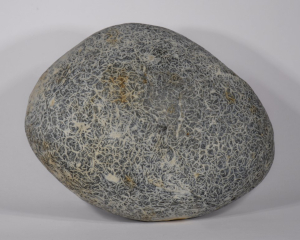
Même si les formations de silex aux formes parfois aventureuses et irrégulières (concrétions) ne sont pas des "fossilisations" d'êtres vivants, des fossiles peuvent tout de même être contenus dans le silex.
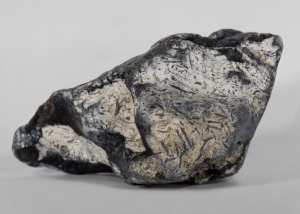
L'empreinte de ce silex montre des parties de plaque d'un autre oursin rare (lance) : Stereocidaris. (Le spectateur regarde l'empreinte de la coque extérieure dans le silex environnant de l'intérieur.)


Le silex extérieur a pris la forme d'une coupe, tandis que les structures en éponge sont clairement visibles sur la surface intérieure. Une fêlure fraîche est visible au fond de la tasse. Ici, les sédiments ont été pétrifiés, puis ont éclaté.
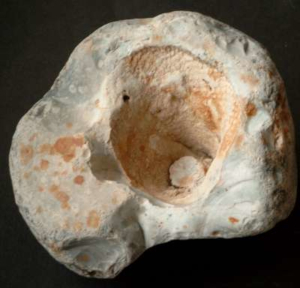
Pour enregistrer cette Eartcache, rendez-vous aux coordonnées indiquées, regardez la zone marquée sur le mur et répondez aux questions suivantes.

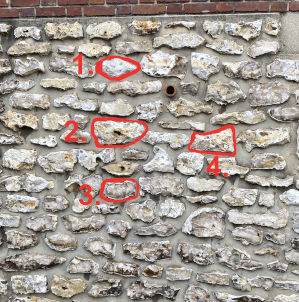
Ce par e-mail ou le centre de messagerie pour moi:
1) Quelles couleurs de silex peux-tu reconnaître ici ? Vois-tu de grandes différences de couleur ?
2) Observe maintenant les numéros marqués sur la partie du mur.
a) Que peux-tu reconnaître au numéro 1 ?
b) Que peut-on voir au numéro 2 ? Comment celle-ci s'est-elle formée ?
c) Que peux-tu reconnaître au point 3 ? Pour t'aider, compare-les aux images du listing.
d) Au point 4, tu vois les restes d'un fossile ? De quoi s'agit-il ?
3) Peux-tu voir d'autres fossiles, éponges ou autres inclusions sur la paroi ?
Si oui, lesquels ?
4) regarde les diverses arêtes de fracture dans le silex. On y voit parfois aussi de petits éclats de givre. Veuillez décrire la cassure et expliquer pourquoi à l'aide du listing.
En outre
5. Prenez une photo de tu et/ou d'un objet personnel (par exemple votre GPS) dans la maison avec le mur en silex et attachez-la à votre bûche !
Sources:
Wikipédia.de
mineralienatlas.de
www.budstone.de
www.quartzpage.de
strand-und-steine.de
[EN] Flint, Flint and Lapis Pyromachus
The name flint goes back to the prehistoric fact that flints can actually start a fire; i.e. when flints and metal are struck against each other at the right angle, fire-forming sparks are created which, in combination with tinder (a fungus) and dry straw/hay, can start a fire.
For this reason, the German chemist Martin Heinrich Klaproth (1743 to 1817) also called flint "Lapis Pyromachus" - the fire-making stone.
Flint is often equated with the term flint. In fact, however, in geology, the term flint flint is used to describe flint that was created in the period between the Cretaceous and the Lower Tertiary (approx. 145 to 61.6 million years).
In Europe one finds large amounts of flint weathered from the Cretaceous chalk cliffs of the Baltic Sea and the English Channel
Properties of flint
Definition of flint: Flint, also known as flint or silex, is a sedimentary rock that was created under marine (= in the sea) conditions.
Fresh flint is usually black to gray in color. Due to weathering, it becomes increasingly milky. The color of flint can be gray, brown, black, greenish, or red; Admixtures of organic material or mineral components, above all hematite, which gives flints a reddish color, are responsible for the colour. But gases or water contained in the rock can also have an influence on the color of flints, which is expressed in lighter colors.
From a chemical point of view, flint consists of silicon dioxide in the form of the microcrystalline quartz variety chalcedony or moganite, sometimes also opal, as the main component with an indefinable water content (SiO2*nH2) - which is why the rock is assigned to the pebbles. A term that is now obsolete and actually summarized stones made of silica.
The fine-grained rock is amorphous (crystals are not formed), forms nodular or flat aggregates. A white crust or patina often forms on the surface of flint nodules as a result of the loss of crystal water.
Flint is characterized by its amorphous, isotropic (lack of a preferred orientation) structure. When a large amount of pressure is suddenly or increasingly exerted on a point of the flint, the kinetic energy is absorbed by the rock and spreads concentrically in the rock, starting from the point of impact. If the impact energy is sufficiently high, the rock is split by the propagating impact waves. The resulting fracture front usually has a conchoidal shape, as can also be observed on broken glass. In the area of a fracture point, the flint has e.g. Shockwaves, the Wallner lines. They arise above all with intentionally split off parts of the stone, which are referred to as flakes.
Flint is a hard rock with a Mohs hardness of 6.5 to 7 on the 10-stage scale of hardness of minerals and rocks according to the mineralogist Friedrich Mohs (1773 to 1839), the density is 2.5 to 2.6 g/cm3 .
Origin and distribution of flints
The formation of flint nodules occurs in several stages and is not fully understood.
Today's flints began to form as early as the turn from the Jurassic to the Cretaceous period around 145 million years ago. Both inorganic - e.g. weathered silicate rock - and organic substances such as shells and skeletons of siliceous sponges, diatoms (silica algae) and bryozoans (moss animals) in seawater provided the starting material for flints.
For millions of years, siliceous solutions displaced the carbonates from the skeletons of the silicic acid suppliers; Silicic acid is the building block of flints. In the first stage, the silicic acid solidifies into a gel by releasing the water it contains - amorphous opal is formed.
Dissolution and recrystallization phenomena characterize the second stage – the formation of porcellanite, i.e. irregular, crystalline opal develops.
When the diagenetic hardening is complete, all the carbonate-containing components in the rock are replaced by silicon dioxide. Skeletons or shells can often be seen as evidence of the organic involvement in the formation of the flint rock.
Fine bands in the flint, resulting from different levels of silicic acid and solidification, so-called banded flint, prove that the silicification proceeds from the inside to the outside.
Chicken gods are also flints in which non-silicified lime has been washed away by seawater, leaving a hole in the rock.
Find examples:
Here we see both irregular and nodular inclusions of black flint in a lighter rock, which is actually heavily silicified limestone that has already been transformed into flint - or to put it another way: flint that is not yet completely lime-free. The elimination of crystal water from the black flint during diagenesis creates a white opal fringe - particularly beautiful in this stone.
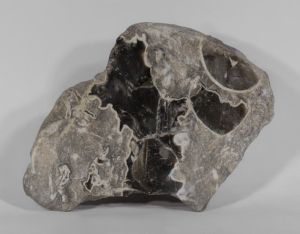
Due to the watery-gel-like variable initial situation or after the weathering out of chalk deposits or even a fossil sea lily stalk, round holes can appear in the flint. Such perforated stones were considered an amulet in ancient times.
From the old Slavic tradition, they are called "hagstones" in the Baltic Sea region and are collected by tourists as lucky charms.

The shotguns very often have a striped pattern. Such bands can be traced back to the rhythmic precipitation of (dust-fine) dark minerals during diagenesis. Banded flints can be very attractive graphically.
 |
 |
| |
irregular concretion |
| |
|
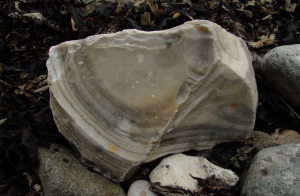 |
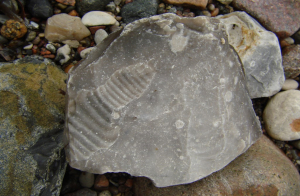 |
| rhythmic growth rings |
rhythmic precipitations |
Although flint appears to the eye as amorphous (= formless, i.e. without recognizable crystal forms), rock crystals can form in the silicic acid substance in fissures and cavities.
The very small crystals often cover existing cavities in the form of a "lawn".
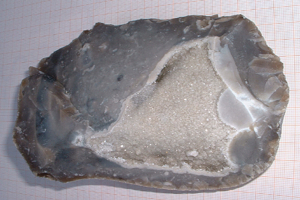

Rarely, one can see developed blue chalcedony, it also appears on fissure surfaces and shows up as a lawn of tiny spherical cloudy formations. Sometimes smooth shotguns partially have a slightly bluish surface. This can be caused by the residue of a chalcedony covering.
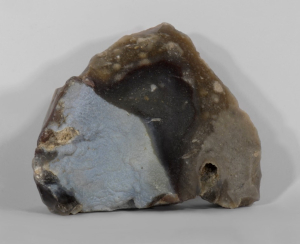
On a beach exposed to the pounding of the waves, even the sharp-edged, hard shotgun rounds out over time.
Sometimes one comes across specially marked stones. They are strewn with small curved furrows, with a dense network of sickle-shaped pressure marks.
This allows them to identify further stresses: parabolic cracks.
During the cold periods, these curved pressure marks were caused by the pressure and the movement of the loading glacier.

Even if the sometimes adventurously irregularly formed flint formations (concretions) are not "fossilizations" of living beings, fossils can still be contained in the flint.

The imprint of this flint shows plate parts of another, rare (lance) sea urchin: Stereocidaris. (The viewer is looking at the imprint of the outer shell into the surrounding flint from the inside.)
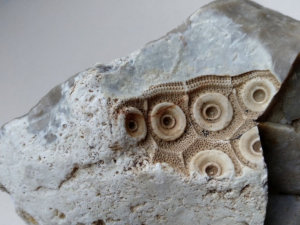

The outer flint has taken on the shape of a cup, while the sponge structures are clearly visible on the inner surface. A fresh crack can be seen at the bottom of the cup. Here sediment was petrified, which then broke out.

Sources:
Wikipédia.de
mineralienatlas.de
www.budstone.de
www.quartzpage.de
strand-und-steine.de
To log this Eartcache, go to the given coordinates, look at the marked area on the wall and please answer the following questions.
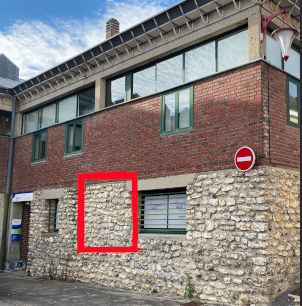

This via email or the message center to me:
-
What colors of flint can you see here? Do you see big color differences?
-
2. Now look specifically at the numbers marked on the section of the wall
a) What can you see in the number 1. What is it about?
b) What is there to see at number 2? How did this come about?
c) What can you see in number 3? Match it to the pictures in the listing to help.
d) At number 4 you see the remains of a fossil? What is it about?
-
Can you see other fossils, sponges or other inclusions on the wall? If yes, which?
-
Look at the various broken edges in the flint. In some cases, smaller frost cracks can also be seen. Please describe the break line and use the listing to explain why this is the case.
Additionally
-
Take a photo of yourself and/or a personal item (e.g. your GPS) at the house with the flint wall and attach it to your log! Sources: Wikipedia.de mineralienatlas.de www.budstone.de/feuerstein/feuerstein.htm www.quartzpage.de/flint.html strand-und-steine.de
[DE] Feuerstein, Flint und Lapis Pyromachus
Der Name Feuerstein geht auf den prähistorischen Umstand zurück, dass man mit Feuersteinen tatsächlich ein Feuer entfachen kann; d.h. wenn Feuersteine und Metall im richtigen Winkel gegeneinander geschlagen werden, entstehen feuerbildende Funken, die in Kombination mit Zunder (einem Pilz) und trockenem Stroh/Heu ein Feuer entzünden können.
Der deutsche Chemiker Martin Heinrich Klaproth (1743 bis 1817) nannte Feuerstein aus diesem Grund auch "Lapis Pyromachus" - der feuermachende Stein.
Oftmals wird Feuerstein mit der Bezeichnung Flint gleichgesetzt. Tatsächlich aber werden in der Geologie unter dem Begriff Feuerstein Flinte zusammengefasst, die im Zeitraum zwischen der Kreidezeit und dem unteren Tertiär (ca. 145 bis 61,6 Mio. Jahre) entstanden sind.
In Europa findet man Feuerstein in großen Mengen verwittert aus den kreidezeitlichen Kreidefelsen der Ostsee und des Ärmelkanals
Eigenschaften von Feuerstein
Definition Feuerstein: Feuerstein, auch Flint oder Silex ist ein Sedimentgestein, das unter marinen (= im Meer) Bedingungen entstanden ist.
Frischer Feuerstein hat meistens eine schwarze bis graue Färbung. Durch Verwitterung wird er zunehmend milchiger. Die Farbe von Feuerstein kann grau, braun, schwarz, grünlich oder rot sein; farbgebend sind dabei Beimengungen organischen Materials oder mineralische Komponenten, allen voran Hämatit, das Feuersteinen eine rötliche Färbung verleiht. Aber auch im Gestein enthaltene Gase oder Wasser können einen Einfluss auf die Farbe von Feuersteinen haben, die sich in helleren Farbgebungen ausdrücken.
Chemisch betrachtet besteht Feuerstein aus Siliciumdioxid in Form der mikrokristallinen Quarzvarietät Chalcedon oder Moganit, teilweise auch Opal, als Hauptbestandteil mit einem nicht definierbaren Gehalt an Wasser (SiO2*nH2) - weshalb das Gestein den Kieselsteinen zugeordnet wird. Ein Begriff, der mittlerweile veraltet ist und eigentlich Steine zusammenfasste, die aus Kieselsäure bestehen.
Das feinkörnige Gestein ist amorph ( Kristalle werden nicht ausgebildet), bildet knollige oder platte Aggregate. Infolge des Verlustes von Kristallwasser bildet sich auf der Oberfläche von Feuersteinknollen häufig eine weiße Kruste bzw. Patina.
Feuerstein wird durch seine amorphe isotrope (Fehlen einer Vorzugsorientierung) Struktur ausgezeichnet. Wenn ein großer Druck schlagartig oder ansteigend auf einen Punkt des Feuersteins ausgeübt wird, wird die kinetische Energie vom Gestein aufgenommen und breitet sich konzentrisch kegelförmig vom Schlagpunkt ausgehend im Gestein aus. Bei ausreichend hoher Schlagenergie wird das Gestein durch die sich ausbreitenden Schlagwellen gespalten. Die hierbei entstehende Bruchfront hat meist eine muschelige Form, wie sie auch an zerbrochenem Glas beobachtet werden kann. Im Bereich einer Bruchstelle weist der Feuerstein u. a. Schlagwellen auf, die Wallnerlinien. Sie entstehen vor allem bei intentionell abgespaltenen Teilen des Steins, die als Abschläge bezeichnet werden.
Feuerstein ist mit einer Mohshärte von 6,5 bis 7 auf der 10-stufigen Skala der Härte von Mineralien und Gesteinen nach dem Mineralogen Friedrich Mohs (1773 bis 1839) ein hartes Gestein, die Dichte beträgt 2,5 bis 2,6 g/cm3.
Entstehung und Verbreitung von Feuersteinen
Die Entstehung von Feuersteinknollen verläuft in mehreren Stadien und ist nicht vollständig geklärt.
Bereits zur Wende vom Erdzeitalter Jura zur Kreidezeit vor etwa 145 Mio. Jahren setzte die Entstehung der heutigen Feuersteine ein. Im Meerwasser befindliche sowohl anorganische – z.B. verwittertes Silikatgestein – als auch organische Substanzen wie chalen und Skeletten von Kieselschwämmen, Diatomeen (Kieselalgen) und Bryozoen (Moostierchen), lieferten das Ausgangsmaterial von Feuersteinen.
Über Millionen von Jahren hinweg verdrängten kieselsäurehaltige Lösungen die Carbonate aus den Skeletten der Kieselsäurelieferanten; Kieselsäure ist der Baustein von Feuersteinen. Im ersten Stadium verfestigt sich die Kieselsäure zu einem Gel, indem enthaltenes Wasser abgegeben wird - es entsteht amorpher Opal.
Auflösungs- und Rekristallisationserscheinungen kennzeichnen das zweite Stadium – die Bildung von Porzellanit, d.h. unregelmäßiger, kristalliner Opal entwickelt sich.
Ist die diagenetische Verfestigung abgeschlossen, sind alle karbonathaltigen Anteile im Gestein durch Siliciumdioxid ersetzt. Als Zeugnis der organischen Beteiligung an der Gesteinsentstehung des Feuersteins sind häufig Skelette oder Schalen zu erkennen.
Dass die Verkieselung von innen nach außen verläuft, beweisen feine Bänder im Feuerstein, resultierend von unterschiedlichen Gehalten an Kieselsäure und Verfestigung, sog. Bänderfeuerstein.
Hühnergötter sind ebenfalls Feuersteine, bei denen nicht verkieselter Kalk durch das Meerwasser ausgespült wurde und ein Loch im Gestein verbleibt.
Fundbeispiele:
Hier sehen wir sowohl irregulär als auch kugelig ausgebildete Einschlüsse aus schwarzem Flint in einem helleren Gestein, das tatsächlich ein stark silifizierter, bereits flintähnlich umgewandelter Kalkstein ist - oder anders gesagt: ein noch nicht gänzlich kalkfreier Flint. Das Ausscheiden von Kristallwasser aus dem schwarzen Flint während der Diagenese lässt einen weißen Opalsaum entstehen - in diesem Stein besonders schön ausgebildet.

Auf Grund der wässrig-gelartig variablen Ausgangssituation bzw. nach dem Herauswittern von Kreideeinlagerungen oder auch eines fossilen Seelilienstängels können runde Löcher im Flint auftreten. Solche Lochsteine galten in alter Zeit als Amulett.
Aus altslawischer Tradition heraus werden sie im Ostseeraum als "Hühnergötter" bezeichnet und von Touristen als Glücksbringer aufgesammelt.
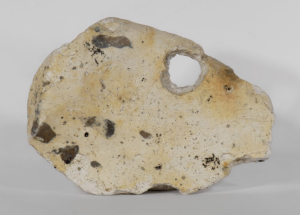
Sehr häufig weisen die Flinte gestreifte Muster auf. Solche Bänderungen gehen auf rhythmisch erfolgte Ausfällungen von (staubfeinen) dunklen Mineralen während der Diagenese zurück. Gebänderte Feuersteine können graphisch sehr attraktiv sein.
 |
 |
| |
irreguläre Konkretionen |
| |
|
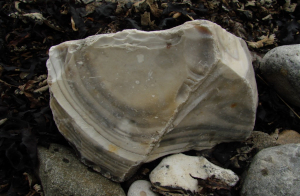 |
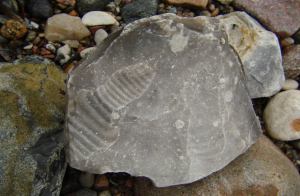 |
| rhythmische Wachstumsringe |
rythmische Ausfällungen |
Obwohl Flint dem Auge als amorph erscheint (= gestaltlos, d. h. ohne erkennbare Kristallformen), können sich doch in Klüften und Hohlräumen aus der Kieselsäuresubstanz Bergkristalle ausbilden.
Die sehr kleinen Kristalle bedecken häufig vorhandene Hohlräume in Form eines "Rasens".


Seltener kann man ausgebildeten blauen Chalcedon sehen, er erscheint ebenfalls an Kluftflächen und zeigt sich wie ein Rasen aus winzigen kugelähnlich wolkigen Gebilden. Zuweilen haben glatte Flinte partiell eine leicht bläuliche Oberfläche. Das kann durch den Rest eines Chalcedon-Belags verursacht sein.
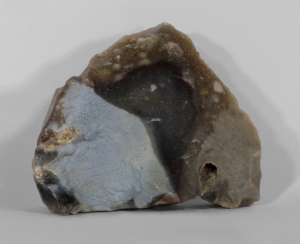
An einem dem Wellenschlag ausgesetzten Strand runden sich mit der Zeit selbst die scharfkantigen, harte Flinte.
Zuweilen stößt man auf besonders gezeichnete Steine. Sie sind übersät von kleinen gebogenen Furchen, von einem dichten Netz sichelförmiger Druckmarken.
Damit lassen sie eine weitergehende Beanspruchung erkennen: Parabelrisse.
Während der Kaltzeiten wurden durch den Druck und die Bewegung des auflastenden Gletschers diese gebogenen Druckmarken verursacht.

Auch wenn die zuweilen abenteuerlich irregulär geformten Flintgestaltungen (Konkretionen) keine "Versteinerungen" von Lebewesen sind, können im Flint doch Fossilien enthalten sein.

Dieser Flint zeigt im Abdruck Plattenteile eines anderen, seltenen (Lanzen-)Seeigels: Stereocidaris. (Der Betrachter schaut hier von innen auf den Abdruck der Außenschale in den umgebenden Flint.)
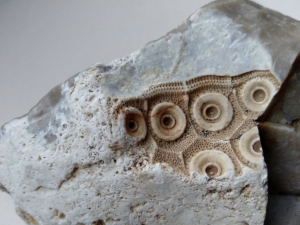
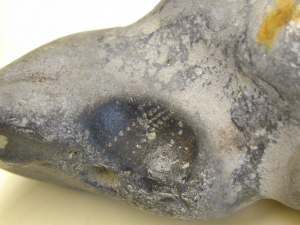
Der äußere Feuerstein hat die Kelchform angenommen, während auf der inneren Oberfläche die Schwammstrukturen gut zu erkennen sind. Auf dem Boden des Kelches ist eine frische Bruchstelle zu sehen. Hier war Sediment mit versteinert, welches dann herausgebrochen ist.

Um diesen Eartcache zu loggen, begebe dich zu den angegebenen Koordinaten, betrachte den gekennzeichneten Bereich an der Wand und beantworte bitte die folgenden Fragen.


Diese via email oder das Messagecenter an mich:
-
Welche Farben des Feuersteins kannst Du hier erkennen? Siehst Du große farbliche Unterschiede?
-
Betrachte jetzt gezielt die markierten Nummern an dem Teilausschnitt der Wand
a) Was kannst Du bei der Nummer 1 erkennen. Worum handelt es sich?
b) Was gibt es bei Nummer 2 zu sehen? Wie ist dieses entstanden?
c) Was kannst Du bei Nummer 3 erkennen? Gleiche es zur Hilfe mit den Bildern im Listing ab.
d) Bei Nummer 4 siehst Du die Reste eine Fossils? Worum handelt es sich?
-
Kannst Du weitere Fossilien, Schwämme oder sonstige Einschlüsse an der Wand erkennen?
Wenn ja, welche?
-
Schaue die diverse Bruchkanten im Feuerstein an. Teilweise sind auch kleinere Frostsprengungen zu sehen. Bitte beschreibe die Bruchkante und erkläre mit Hilfe des Listings, warum dieses so ist.
Zusätzlich
-
Mache an dem Haus mit der Feuersteinwand ein Foto von Dir und/oder einem persönlichen Gegenstand (z.B. Deinem GPS) und hänge es an Deinen Log an!
Quellen:
Wikipedia.de
mineralienatlas.de
www.budstone.de
www.quartzpage.de
strand-und-steine.de